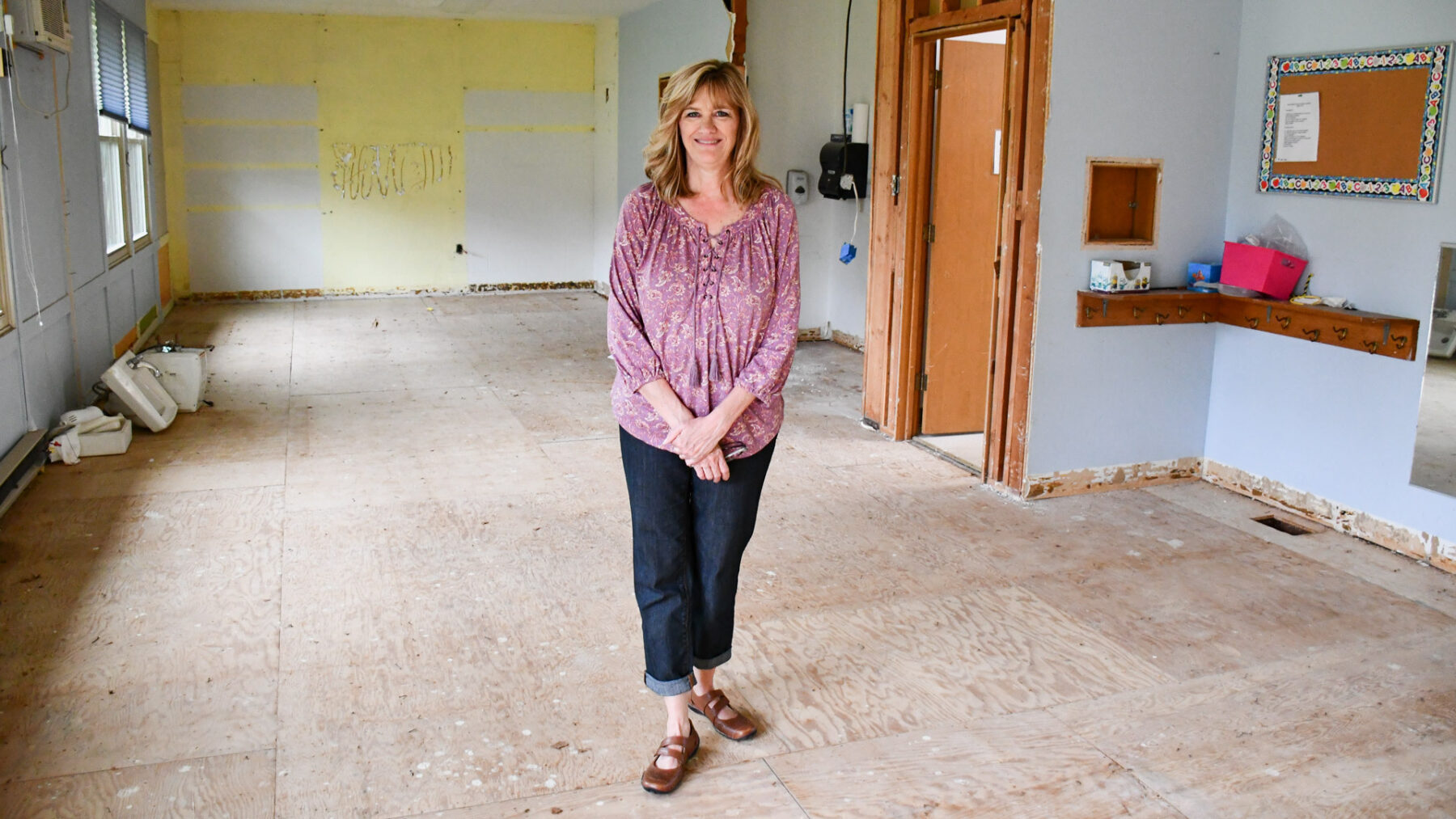CFO Stories
Grants improve access for child care in the rural Ozarks
How a $300,000 anonymous gift is helping decrease barriers for daycares and working parents in ten communities

How a $300,000 anonymous gift is helping decrease barriers for daycares and working parents in ten communities
Getting to work can be complicated when children are involved, and for more reasons than simply trying to get out the door. For parents in rural parts of the Ozarks, this reality can be especially challenging based on economic and availability factors that make finding — and keeping — a spot at a daycare difficult.
While the issues contributing to such realities are complex, a layer of support was announced in late 2021 through the Ozarks Early Childhood Support Grant Program. An anonymous donor pledged $300,000 through the Community Foundation of the Ozarks to reduce barriers to quality, affordable child care in rural communities.
“We focused on child care as a component of working through solutions we could provide that impact workforce issues in the region,” says Bridget Dierks, vice president of programs at the CFO. “We wanted to positively impact the lives of individuals who would like to return to work and only lack quality child care to be able to do it.”
In December, the CFO announced 10 agencies throughout the region as the grant recipients. The issues they face — and funding to help alleviate them — are as broad as the region itself, but a key need is greater staffing support. More than half of the pool of funding was devoted to this issue.
The need for child care — with regards to both quality and quantity — is growing across the state, says Robin Phillips, CEO of Child Care Aware of Missouri. The nonprofit organization offers services focusing on the improvement of a child’s experiences and environment from birth until around age five.
“Prior to the pandemic, child care has always been an issue in the sense of there’s never been enough — especially for infant-toddler care, especially in your rural communities, especially where there are employers with second shifts and overnight shifts,” Phillips says during a meeting in June with Springfield’s Good Community group. She was joined in the discussion with Dana Carroll, vice president of early childhood and family development with the Community Partnership of the Ozarks, and Sally Payne, the City of Springfield's director of workforce development.
Phillips also shared that since the onset of the COVID-19 pandemic, Missouri has lost 12% of its child care programs, outpacing the national trend of a 10% decrease.
According to Care Aware’s website, a child care desert is defined as a county with greater than 50 children below age 5 with either no child care providers, or so few options that there are more than three times the number of children as licensed slots.
“You have master’s-degree early education teachers and child care educators leaving to go to ALDI and Costco because they can make $17, $18 an hour and have benefits.”
“Prior to the pandemic, 63 counties were deserts. Now we’re at 76,” Phillips says. “That map would look very different if we got even more granular on infant-toddler care.”
Other programs are operating at lower capacity due to staffing challenges, tied in part to an average wage for child care workers of $11.83 an hour.
“You have master’s-degree early education teachers and child care educators leaving to go to ALDI and Costco because they can make $17, $18 an hour and have benefits,” says
Phillips. “So there’s a huge gap and wage-disparity issue.
“If a child care program is licensed to care for 50 children, I guarantee you they don't have 50 children because they can’t find people to work.”
While daycares struggle in recruiting and retaining staff, another funding-related concern can simply be the ability of parents and guardians to pay for their children to attend.
One place facing this reality is the I Can Too Learning Center in Dent County. The kid-friendly center, filled with color and walls painted with images of smiling children, received $30,000 through the grant program to supplement tuition payments for low-income families.
Nancy Major, founder of the Salem center, regularly sees situations in which parents want to pay their bills, but an unexpected expense or change in state subsidy suddenly makes things very difficult.

The I Can Too Learning Center, which provides care for young children in Salem, received a $30,000 grant to supplement tuition payments for low-income families.
“My parents would come in and they go, ‘Is there any way I can wait to pay you until my next paycheck? Because our washer just went out and I have to go buy a new one,’” she shares as an example.
Those types of situations led her to begin a scholarship program through which parents can apply to have up to half of their out-of-pocket expenses covered for a set period of time. However, due to funding limitations, she wasn’t able to offer extended support. That’s where the additional grant funding comes in: It allows parents to have an expanded chance to get on their feet.
“We never had enough to just really give parents a break. So, when we applied for this, that’s what we did,” says Major, who notes that she approached families who had struggled in the past to let them know the grant funding was available.
“I talked to them and said, ‘Do you want to apply for a scholarship? Because we have some extra funds now through the scholarship fund that could give you a chance to kind of get everything pulled together.’”
Currently, they are assisting 32 of the center’s 148 children through the program.
“When I first started, there were three large daycares in town. We are the final one.”
Applications are evaluated on a case-by-case basis by a committee, which will make decisions based on the family’s needs. All applicants must be making an effort to work, attend school or apply for jobs. In the case of children in the foster care system, the funds are used to reduce the bill to zero.
While Major has seen the need increase for help, she’s also seen an increase in need for capacity.
“When I first started, there were three large daycares in town,” she says. “We are the final one.”
Expanding to new ages
Accessibility — both overall and especially for certain ages — is an issue in other parts of the state as well. It’s the case in Phelps County, where spots for infants are basically impossible to find in centers.
“The state considers Phelps County a desert because we don’t have near enough to meet the demands,” says Tracy James, director of First Presbyterian Church of Rolla’s Presbyterian Preschool. “Basically, if you’re thinking of getting pregnant, you have to put your name on the list.”
Nearly one-third of Missourians live in a childcare desert, says information from Child Care Aware.
In Phelps County, however, eight more spots will soon be available after construction is complete on an infant care room at the preschool, which is funded in part by $15,233.76 from the grant program.

Tracy James, director of the Presbyterian Preschool in Rolla, is overseeing the grant-funded construction of a new infant care room at First Presbyterian Church to meet the extreme need for child care in Phelps County. “Basically, if you’re thinking of getting pregnant, you have to put your name on the list.”
Walking down the hallway of the center, filled with color and the voices of nearby children, James opens the door to the future infant room.
“The stairs will come out, and the ramp will come all the way up,” says James, holding open a second door from the room to the outside.
Although the room is currently empty and down to bare bones, in effect, it’s already full.
“Even when rumors started that we might be taking infants, phone calls came,” says James.
Given the extremely low number of spots locally available, she says that individuals largely rely on their own solutions to find care for their youngest children. That was even a lived reality for James after her daughter had no luck in placing her grandchild prior to his birth.
“My mom and I kept him, which they consider ‘underground,’” says James. “Because you aren’t regulated.”
In the southeast corner of Missouri, another proof point of the need for greater access is seen through Bell City, where licensed preschool options are limited.
“We were the only licensed facility within a 45-minute drive of the area,” says Jeremy Hahn, executive vice president of Life360 Community Services, of when the organization took over the operation a couple of years ago.
That reality is compounded by another problem facing the small Stoddard County community: A high rate of poverty, found across parts of the Ozarks, which can complicate families’ abilities to make payments for their children to attend.
Of the four-county region that Life360 serves from its Bell City location: “They are above the 90% free and reduced lunch rate. Ninety percent,” Hahn says, emphasizing the metric often used to illustrate the economic reality of particular areas.
Those needs will be served through $30,000 from the grant program, which will support increased staffing hours at the center and the addition of a family support coordinator.
“A family support coordinator is really a resource manager,” says Hahn of the coordinator role, which is standard at Life360’s preschools. “It can be as simple as when we receive donated products, they will package it and give it to families.”
“Our family support coordinators make sure when parents get in trouble — if, say, they’re late on a payment, they begin to ask questions and work with them. Indirectly, that impacts us tremendously.”
Other times, however, the coordinators can identify challenges in a family’s ability to succeed, such as with housing, transportation and interpersonal situations.
“Our family support coordinators make sure when parents get in trouble — if, say, they’re late on a payment, they begin to ask questions and work with them,” Hahn says. “Indirectly, that impacts us tremendously.”
He also shares that the coordinators can support families through services including budget training and help, financial management, and even social-emotional development.
“We do work with parents on healthy bedtime routines,” adds Hahn. “Maybe their kiddo’s lacking in being able to identify letters, and so they’ll work with them even on the educational piece a little bit, at least as it pertains to ways parents can help them at home.”
While child care costs a great deal, a lack thereof also is an expense that families, employers and children themselves have to face.
“A family of four, with two kids in child care, will spend $22,000 a year on tuition,” Carroll says.
For parents in the state of Missouri — who have a typical median household income of $57,290 a year, Phillips says — it may mean the choice between working and not. Or, in some cases, trading work at a child care center to help cover tuition.
“There are some providers who go into child care because it’s the only place they can find to put their kids,” Carroll says, noting that some get that care at a reduced rate.
That reality trickles into local life in ways other than a lack of take-home pay. It also means fewer tax dollars are being pumped into the economy.
“We need to look at child care as an investment. It is an industry and sector that is a little behind the times. You can’t supply-and-demand your way out of it.”
For employers, it may mean not operating at a business’s greatest potential. The latter is an especially tricky reality in the current job market, where industries have worked to increase their minimum wage to attract workers, but now have to address corporate culture, Payne says.
An example: More than 80% of U.S. parents prioritize child care benefits, but only 6% of companies offer them.
“We need to look at child care as an investment,” Payne says. “It is an industry and sector that is a little behind the times. You can’t supply-and-demand your way out of it. You can’t add more kids to your center, because, ‘Oh, that will generate more revenue.’ No, that's going to require more teachers because of the ratios with teachers to children.
“This sector, more than any, supports every other industry. It’s up to us to support it.”
Payne gave an example of how a lack of child care affected one family in particular: A single dad with three children went through a training program and was offered a job that started around $20 per hour — but he wasn’t able to take it because he can’t afford the necessary child care.
On the issue of capacity, options such as subsidies and apprenticeships are currently being discussed, Payne says.
But the need for affordable and available child care isn’t the only goal: Quality care is crucial, too. Not only are people needed to supervise and ensure children’s safety, but early childhood is a crucial time for cognitive development and stimulation to help brain function develop optimally.
“The brain is developed 95% by the time the child is age five,” Phillips says. “If children are sitting in a car seat in front of the TV all day, and no one’s singing, no one’s reading, those synapses are not firing, and you can’t get it back. We have to work together to find places and advocate for quality, which is really expensive."
In different ways, so many issues tie back to funding — and the future of generations to come.
By Kaitlyn McConnell, writer in residence for the Community Foundation of the Ozarks · This story is featured in the summer 2022 edition of Passion & Purpose: The CFO Magazine.